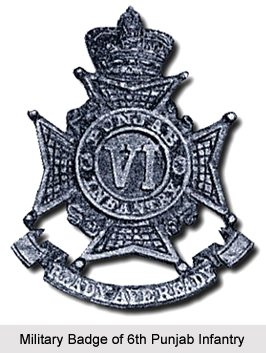 The 6th Regiment of Punjab Infantry or 6th Punjab Infantry was also known as the 59 Scinde Rifles (Frontier Force) unit. It was an infantry regiment that was regarded as one of the most esteemed units of the British Indian Army. The regiment was raised by the Honourable British East India Company as the Scinde Camel Corps in the year 1843. The military battalion was included as a part of the Punjab Irregular Force (PIF) in 1856. Later it was renamed as the 59th Scinde Rifles (Frontier Force) in the year 1904. Eventually in 1922, the 6th Punjab Infantry was designated as the 6th Royal Battalion (Scinde) 13th Frontier Force Rifles.
The 6th Regiment of Punjab Infantry or 6th Punjab Infantry was also known as the 59 Scinde Rifles (Frontier Force) unit. It was an infantry regiment that was regarded as one of the most esteemed units of the British Indian Army. The regiment was raised by the Honourable British East India Company as the Scinde Camel Corps in the year 1843. The military battalion was included as a part of the Punjab Irregular Force (PIF) in 1856. Later it was renamed as the 59th Scinde Rifles (Frontier Force) in the year 1904. Eventually in 1922, the 6th Punjab Infantry was designated as the 6th Royal Battalion (Scinde) 13th Frontier Force Rifles.
History of 6th Regiment of Punjab Infantry
The army unit of the Scinde Camel Corps was formed by Lieutenant R Fitzgerald on 1 December 1843 at Karachi. Initially the regiment comprised of camel-mounted infantry and focussed on maintaining peace on the Sindh frontier. Later in the year 1853, it became part of the Punjab Irregular Force and was titled as the 6th Regiment of Punjab Infantry. The Punjab Irregular Force later became celebrated as The Piffers or the Punjab Frontier Force. It included 11 regiments of infantry, 5 regiments of cavalry and 5 batteries of artillery, besides the Corps of Guides. Its primary objective was to sustain order on the Punjab Frontier. The 6th Regiment of Punjab Infantry participated in a number of frontier military operations over the next 5 decades. The regiment remained loyal to the East Indian Company during the Sepoy Mutiny in 1857 and was involved in several crucial operations.
After the reforms in the British Indian Army in 1903 administered by Lord Kitchener, the army unit was re-designated as the 59th Scinde Rifles (Frontier Force). The class composition of the regiment in the year 1914 included one company of Punjabi Muslims, two companies of Sikhs, two companies of Dogras and three companies of Pathans. During the First World War, the troops were posted on the Western Front from 1914 to 1915 and also took part in the Battle of Givenchy and the Battle of Neuve Chapelle. The unit also participated in the Second Battle of Ypres and the Battle of Loos. Lieutenant William Bruce was bestowed with the Victoria Cross for the service provided by the regiment during the Battle of Givenchy. Later in the year 1916, the 6th Punjab Infantry was stationed in Mesopotamia and took part in the military operations for the Relief of Kut al Amara on the Tigris Front.
The troops also fought in the operations north of Baghdad at Tikrit and Daur and took part in the capture of Baghdad. It was sent Palestine in 1918 and fought in the Battle of Megiddo as well. Due to its valiant service, the regiment was designated as a Royal battalion in the year 1921. After the end of the First World War, the 6th Regiment of Punjab Infantry was united with the 55th Punjabi Rifles, 57th Punjabi Rifles, 58th Punjabi Rifles and the 2 battalions of 56th Punjabi Rifles (Frontier Force) to raise the 13th Frontier Force Rifles in the year 1922. The 6th Punjab Infantry became the 6th Battalion of the new unit. The regiment provided valuable military services during the Second World War and served in the Italy, Palestine, Syria, Iraq, Persia, North Africa, Eritrea and in the Sudan.
Designations of 6th Regiment of Punjab Infantry
The 6th Regiment of Punjab Infantry of the British Indian Army held many titles through out the reorganisation of the army. These are listed as follows -
* Scinde Camel Corps - 1843
* Scinde Rifle Corps - 1853
* 6th Punjab Infantry - 1856
* 59 Scinde Rifles (Frontier Force) - 1904
* 59th Royal Scinde Rifles (Frontier Force) - 1921
* 6th Royal Battalion (Scinde) 13th Frontier Force Rifles - 1922
* 6th Royal Battalion (Scinde) The Frontier Force Rifles - 1945






































